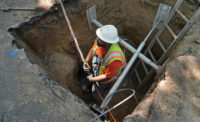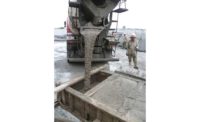Boosters for a more sustainably produced cement, which slashes greenhouse gas emissions up to 40% compared to ordinary portland cement production, say the material, called limestone calcined clay cement, is the next best embodied carbon reducer for concrete since portland limestone cement. But enthusiasts of the material, called LC3, see obstacles to its widespread production and use, especially in the U.S., where cement suppliers are only beginning to consider producing it.
“Things are escalating now,” especially with the focus on climate change, says Karen Scrivener, a professor of construction materials at the École Polytechnique Fédérale de Lausanne, in Switzerland, which has led the development of LC3 since 2005, recently through the seven-year-old LC3 Project. Still, “there is resistance to change and a lot of hand holding needed” to convince stakeholders to use LC3, she adds.
LC3 is based on a blend of limestone and calcined clay pozzolan. Calcined clay, or metakaolin, is produced by heating a source of low-grade kaolinite clay to between 650° C and 750° C. Both limestone and low-grade clays are available in abundant quantities, says the LC3 Project.
Clinker production accounts for most of the carbon content of cement. The LC3 formula is 50% clinker, 30% calcined clay, 15% limestone and 5% gypsum. Portland cement is about 91% clinker, while portland limestone cement (PLC)—also a blended cement—is 83% clinker, according to the Portland Cement Association (PCA). LC3 also has more limestone than portland cement, which contains up to 5%, and PLC, which has 5% to 15% limestone.

Cementos Argos has pioneered use of the material on structures in South America.
Photo courtesy Cementos Argos
Major Innovation
Calcined clay and limestone are commonly used as supplementary cementitious materials. The major innovation in LC3 is the reduction in clinker content to 50%, according to the LC3 Project. Scrivener says research is underway to reduce clinker further—to 30% or lower—and still maintain performance characteristics.
“The LC3 materials have a synergistic effect and perform similarly to ordinary portland cement,” according to the LC3-Project, which shares all of its research products at no charge. “Significant energy savings are achieved because calcined clays are more malleable and are heated at approximately 700-800° C, whereas the manufacture of clinker requires a temperature of 1400-1500° C.”
LC3-50, with a clinker content of 50%, is widely promoted and accepted under cement standards applicable in Europe, India, the U.S., Cuba and much of South America, according to the group, funded by the Swiss government and ClimateWorks Foundation.
LC3 concrete in U.S. pavements and slabs, and especially for structural concrete, is far off. In India and South America, however, it has been used in low-rise concrete buildings. One of several in India is the New Delhi office of the Swiss Agency for Development and Cooperation at the Annex to the Swiss Embassy. Additionally, Cementos Argos is supplying LC3 for structures in South America.
Another obstacle to LC3 proliferation is the capital investment required by cement producers. It requires a separate kiln line and a flash calcinator.
“We’re talking about a heavy capital investment” that could easily reach $30 million or $40 million, says Cheng Qi, technical center director for Ash Grove Cement, which is investigating LC3 production.
Several other PCA members in addition to Ash Grove also are investigating “available clay sources to determine their potential suitability for a calcined clay cement product,” said Rick Bohan, PCA senior vice president for sustainability, in an e-mail. “We would expect some users to choose calcined clay cements as they become more available,” he says.
There are those outside the LC3 Project who think the material has potential, but with caveats—especially for structural concrete. “I see LC3 as an overall positive development because it uses clay deposits that exist in abundance,” says Andreas Tselebidis, director of sustainable concrete technology and solutions at Master Builders Solutions.

The Annex to the Swiss Embassy in New Delhi was completed in 2015 with LC3 concrete.
Photo courtesy LC3 Project
But he cautions that research is needed to determine which clays can be used. Clay with a high smectite, or bentonite, content, might not be suitable for structural uses, Tselebidis postulates.
Also for structures, there is a need for long-term performance data on creep, thermal behavior, rigidity and fire resistance, says Tselebidis. There is no data, for example, regarding behavior over time of post-tensioned concrete that contains LC3.
Both Tselebidis and Qi agree the cement plant needs to be near the clay source to make the carbon reductions over portland cement worthwhile. Lionel Lemay, executive vice president, structures and sustainability, at the National Ready Mixed Concrete Association, thinks the barriers to LC3 adoption in the U.S. are mostly economic, not technical, as with most new products. Contractors will use LC3 if all the technical issues are resolved around it and “if there is no risk,” says Tselebidis.
All agree that material producers and other stakeholders need to educate architects and structural engineers about LC3 and how to specify LC3 concrete. The material “is going to be a very important piece of the [sustainability] puzzle,” predicts Qi, but that could take three to five years.






Post a comment to this article
Report Abusive Comment